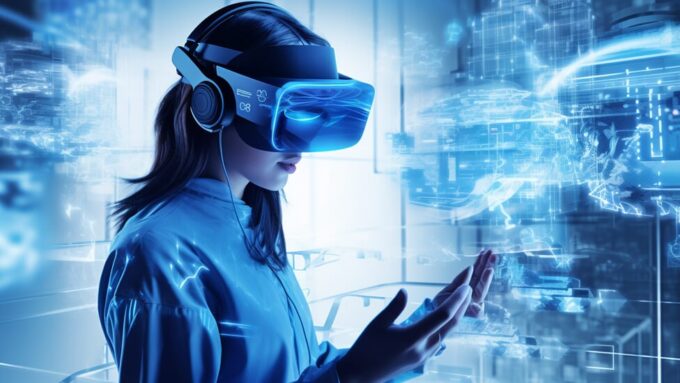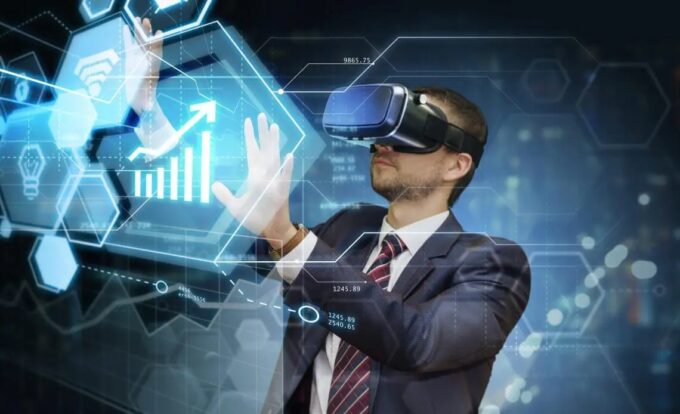The use of augmented reality (AR) and virtual reality (VR) in marketing and advertising is on the rise, with businesses increasingly leveraging these cutting-edge technologies to create more immersive customer experiences. AR/VR development companies offer marketers a powerful tool to engage customers in innovative ways that traditional media cannot.
Using augmented or virtual reality, customers can be transported into an alternate reality where they can interact with products and services in ways that would otherwise be impossible. It’s this level of interactivity that enables brands to create more memorable experiences for their customers.
One example of how AR/VR are being used in marketing and advertising is through 360-degree videos. This type of video allows customers to view a product or service from all angles, giving them a complete look at the item before they make a purchase. Many Brands collaborate with Virtual Reality development companies to incorporate Virtual reality into their promotional events, allowing customers to explore new products in an immersive way.
AR/VR in Marketing
- Enhancing Experiences: AR/VR development solutions and technology allows companies to create immersive and interactive content that enhances the customer experience. By utilizing this technology, marketers can create a unique and memorable experience for their customers that is not only engaging but also memorable. This technology has the potential to revolutionize the way marketing campaigns are designed and executed.
- Immersive Brand Storytelling: AR/VR allows marketers to tell a more engaging story about their brand and products. By leveraging these technologies, marketers can create digital experiences that transport customers into another world, allowing them to explore products and services in an immersive way. This type of storytelling can help brands create an emotional connection with their customers that traditional media cannot provide.
- Increased Engagement: AR/VR technology offers marketers the opportunity to increase customer engagement in a more meaningful way. By allowing customers to interact with products and services, marketers can create experiences that are more engaging and memorable. This type of engagement can help brands foster relationships with their customers, which can lead to increased loyalty and sales.
- Increased Reach: The use of AR/VR technology in marketing campaigns can help companies reach wider audiences. By leveraging these technologies, marketers can create content that is more accessible to customers and can be viewed on multiple platforms. This increased reach can help brands optimize their campaigns for maximum exposure and create a greater impact on their target audiences.
- 5 . Improved Analytics: AR/VR technology can provide marketers with insights into customer behavior that can help inform future campaigns. By collecting data on how customers are interacting with products and services, marketers can gain valuable insights into the effectiveness of their campaigns and use this information to optimize their marketing strategies.
- Cost Savings: AR/ VR technology can help companies save money on marketing campaigns by reducing the cost of production. With this technology, marketers can create high-quality content in a more affordable and efficient way, allowing them to optimize their campaigns without breaking the bank.
The integration of AR/VR developers in marketing campaigns can significantly improve the customer experience. By providing customers with an immersive and interactive experience, brands can create a unique connection that traditional media cannot offer.
Advantages and Disadvantages of AR/VR in Marketing

Source: future-business.org
Advantages:
- Immersive Experiences: Augmented Reality (AR) and Virtual Reality (VR) allow businesses to create highly immersive experiences for their customers. This can be used to help customers better understand a product, allowing them to interact with it in a more meaningful way or even take part in a virtual tour of the business’s premises.
- Increased Engagement: By using AR/VR in marketing campaigns, businesses can increase customer engagement with their brand and products. This can be used to help customers better understand the product or service in an interactive way, leading to an improved customer experience.
- Improved Analytics: Companies can use AR software solutions and technology to collect data on how customers are interacting with their products and services. This data can be used to inform future campaigns and help businesses optimize their strategies for maximum impact.
- Cost Savings: AR/VR technology can help businesses save money on production costs as they are able to create high-quality content in a more efficient manner.
Disadvantages:
- Limited Reach: AR/VR technology is still relatively new and as a result, it can be difficult for businesses to reach wider audiences who may not have access to the necessary hardware.
- Technical Challenges: AR/VR technology can come with its own set of technical challenges that could lead to disruptions in the customer experience.
- Costly Hardware: The hardware used for AR/VR technology can be costly which could make it prohibitive for some businesses.
- Enhanced Creativity: AR/VR technology can be used to create highly engaging and creative content for marketing campaigns. This can help businesses stand out from the competition and create unique experiences for their customers that they are likely to remember.
AR/VR in Advertising

Source: fxmweb.com
- Expansion of Reach: AR and VR technology is quickly expanding the reach of advertising campaigns. With AR/VR, companies can create immersive experiences that bring their products to life and capture the attention of a wide range of audiences. This technology allows marketers to target a variety of demographics, from young adults to seniors, by providing an interactive experience that appeals to all ages .
- Enhanced Engagement: The use of AR/VR in advertising can help businesses create more engaging experiences for their customers. By leveraging this technology, marketers can provide an immersive experience that allows customers to interact with products and services in a meaningful way. This type of engagement can help brands develop stronger relationships with their customers, leading to increased loyalty and sales .
- Improved Analytics: The use of AR/VR in advertising can provide marketers with valuable insights into customer behavior. By collecting data on how customers are interacting with products and services, marketers can gain a better understanding of the effectiveness of their campaigns and use this information to optimize their strategies for maximum impact.
- Cost Savings: AR/VR technology can help companies save money on advertising campaigns by reducing the cost of production. With this technology, marketers can create high-quality content in a more affordable and efficient way, allowing them to optimize their campaigns without breaking the bank.
- Improved Branding: The use of AR/VR in advertising can help brands create a strong connection with their customers. By providing customers with an immersive and interactive experience, brands can create a unique bond that traditional media cannot offer. Additionally, this type of technology can help businesses build their brand identity and increase customer loyalty.
- Enhanced Shopping Experience: AR/VR technology can significantly improve the shopping experience for customers. By providing shoppers with an engaging and interactive experience, brands can give customers an immersive look into their products before they make a purchase. Additionally, this type of technology can provide helpful product information and tips to help customers make informed decisions.
The use of AR/VR in advertising has the potential to revolutionize the way brands interact with their customers. By creating engaging, interactive experiences, marketers can build stronger relationships and increase customer loyalty.
Advantages and Disadvantages of AR/VR in Advertising

Source: iptek.co.id
Advantages:
- Engagement: AR/VR can create an incredibly engaging and interactive experience for customers, allowing them to explore products in a more immersive way. This type of technology can also help brands build stronger relationships with their customers, leading to increased loyalty.
- Reach: AR/VR technology can expand the reach of advertising campaigns beyond traditional media, enabling marketers to target a wider range of audiences.
- Insights: AR/VR can provide valuable insights into how customers are interacting with products and services, giving marketers an understanding of the effectiveness of their campaigns. This data can be used to optimize strategies for maximum impact.
- Cost Savings: Using this technology in advertising campaigns can reduce production costs, allowing businesses to save money without sacrificing quality.
Disadvantages:
- Limited Usability: AR/VR technology is still in its infancy, making it difficult to use for certain types of campaigns. Additionally, this type of technology can be expensive and time-consuming to develop, which can limit its use.
- Potential Privacy Issues: Using this type of technology in advertising campaigns can raise privacy concerns as it requires collecting personal data from customers.
- Lack of Experience: Many marketers lack the experience necessary to effectively use AR/VR in their campaigns, meaning they may not be able to get the most out of this technology.
- Technical Challenges: AR/VR can present technical challenges that may hinder its use in advertising campaigns, such as compatibility and latency issues.
Conclusion
The potential of augmented reality (AR) and virtual reality (VR) in the marketing and advertising industry is immense. This new technology has opened up a number of opportunities for marketers to interact with their customers in more engaging ways. AR/VR can be used to create immersive experiences that are far superior to traditional methods, allowing brands to forge deeper connections with their audience.
Virtual reality vs augmented reality are some of the hottest topics in technology right now. Both have the potential to revolutionize the way we interact with data, information, and one another. Additionally, AR/VR technologies offer a number of advantages, such as cost savings, expanded reach, and valuable insights. Despite these benefits, there are still some drawbacks to using this technology that marketers need to consider. Overall, AR/VR has the potential to revolutionize the way brands interact with their customers and create lasting relationships.







